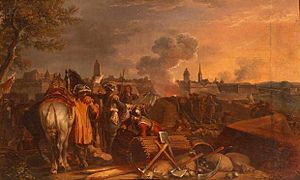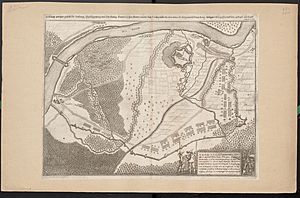Siege of Philippsburg (1644) facts for kids
The Siege of Philippsburg was a battle that happened during the Thirty Years' War. From August 25 to September 12, 1644, French forces attacked the Philippsburg fortress near the Rhine River. After a tough battle near Freiburg, the French army, led by the Duc d'Enghien, decided to attack Philippsburg instead. They captured the fortress in just two weeks. This victory allowed the French to take other important cities like Worms, Oppenheim, Mainz, and Landau soon after.
Quick facts for kids Siege of Philippsburg |
|||||||
|---|---|---|---|---|---|---|---|
| Part of the Thirty Years' War | |||||||
 Painting of the siege by Jean-Baptiste Le Paon (1769) |
|||||||
|
|||||||
| Belligerents | |||||||
| Commanders and leaders | |||||||
| Strength | |||||||
| 5,000 men | 500 men | ||||||
Contents
Why Philippsburg Was Important
Philippsburg Fortress was named after Speyer's Prince-Bishop Philipp Christoph von Sötern. He built it in the village of Udenheim because he felt unsafe. His Protestant neighbors, the Margraviate of Baden-Durlach and the Electoral Palatinate, were a threat. They stopped his first attempts to build defenses in 1618.
In 1621, Protestant soldiers attacked the area. Bishop Sötern was too weak to fight them. He went to Udenheim and fortified it again. After Catholic armies won battles in 1622, Sötern finished building the fortress by 1623.
A Fortress in Demand
Bishop Sötern, who was also an Archbishop-Elector of Trier, soon had problems with Spain. Spain had taken parts of the Palatinate. They wanted to protect their important military route to the Netherlands. Bishop Sötern feared Spain would take his fortresses. So, he looked for help from France.
In 1632, Protestant Sweden advanced quickly. Sötern tried to give his fortresses, Ehrenbreitstein and Philippsburg, to France. Ehrenbreitstein was given to France. But Philippsburg's commander, Caspar Baumberger, refused. He kept the fortress for Emperor Ferdinand II. The Swedes captured Philippsburg in 1634 with German allies. But Baumberger took it back in a surprise attack a year later.
France Joins the War
When Spanish troops captured Bishop Sötern in 1635, France used this as a reason to declare war on Spain. France joined the war on Sweden's side. It was very important for France to control the Rhine River. This would allow their troops to move and get supplies within the Holy Roman Empire.
However, France lost its base at Ehrenbreitstein in 1637. This meant the middle Rhine area was controlled by the Emperor. Only after Bernard of Saxe-Weimar won battles in 1638 did France get the important fortress of Breisach on the upper Rhine. From there, French troops still had to cross the Black Forest to threaten the Emperor and his allies.
France could not advance further until 1643. Then, an attack led by Jean-Baptiste Budes, Comte de Guébriant captured Rottweil. Guébriant was badly wounded and died. His replacement, Josias Rantzau, was surprised by Bavarian forces in 1643. The Bavarians captured him and destroyed his army.
In 1644, the Bavarian commander, Franz von Mercy, went on the attack. He took back Überlingen in May and Freiburg im Breisgau in July. The French army, rebuilt by Vicomte de Turenne, finally stopped Mercy. This happened when the Duc d'Enghien joined them in July 1644. Both generals attacked Mercy's army near Freiburg in August. They suffered heavy losses. Mercy only retreated when the French moved around Freiburg to cut off his supplies.
The Siege of Philippsburg
General Turenne convinced d'Enghien not to try to retake Freiburg. Instead, they marched north to attack Philippsburg. French cavalry rode through Baden, followed by their infantry. Most of the French army took control of the area near the Rhine. Only 5,000 men were used to surround Philippsburg. They arrived on August 25.
The Imperial soldiers defending the fortress had 500 men. Their commander was Caspar Baumberger. They had 100 cannons. But they did not have enough soldiers or space to use many cannons at once. Also, the swampy areas that usually protected the fortress had dried up due to a hot summer.
Baumberger was not confident in his men. On August 26, he gave up a small fort northwest of the main fortress. He wanted to focus on defending the main part. D'Enghien first built defenses to protect his siege works. This was in case Mercy tried to send help.
Mercy had marched east of the Black Forest. He was waiting for more Imperial soldiers. He sent over 1,000 cavalrymen to stop d'Enghien. The French soldiers managed to fill the enemy's ditches and dig their own trenches. This happened even after the Philippsburg soldiers attacked them on August 26.
The French artillery, led by Turenne, set up their cannons on August 30. They began firing at the fortress walls. The Imperial soldiers could only use three cannons at a time on each side. These cannons were often destroyed by Turenne's fire. But they were always replaced with spare ones.
Baumberger believed he could not hold Philippsburg any longer. He offered to surrender on September 9. This was just one day after Mercy had joined forces with more Imperial troops. On September 12, Baumberger left the fortress with his remaining soldiers and two cannons.
What Happened Next

After taking Philippsburg, French troops crossed the Rhine. They captured most enemy forts on the left bank. This included Worms, Oppenheim, Mainz, and Landau. Only the Spanish fort at Frankenthal was not taken. The soldiers in Landau resisted for five days. The other towns surrendered without a fight.
The Elector of Mainz had fled. The city leaders surrendered Mainz to the French on September 17. This was against the wishes of the 800 Imperial soldiers there. It happened even though 700 more soldiers had arrived to help.
This victory gave France an easy route into Germany, north of the Black Forest. This made it easier to attack Bavaria. It also cut off Duke Charles of Lorraine from his allies. He lost his last strongholds in Lorraine in 1645 and 1646.
Even though Mercy took back some towns later in 1644, the ruler of Bavaria, Maximilian, believed the war could not be won by fighting. He then urged the Emperor to make a separate peace with France. However, he still helped the Emperor defend Bohemia against the Swedes.
In 1645, the Emperor agreed to free Archbishop-Elector Sötern. The condition was that Sötern would take Philippsburg from France and give it back to the Emperor. But Sötern had other plans. He signed a treaty with France in 1646. This allowed France to keep soldiers in the fortress permanently.
France's control of Philippsburg was confirmed in the Peace of Westphalia in 1648. Imperial troops did not take it back until 1676. Philippsburg was captured again in 1688 and 1734. A military expert, Carl von Clausewitz, later called it a "model of a badly situated fortress." This was because it was too far from the Rhine to get help from the river. But it was close enough for the river to limit its use.


